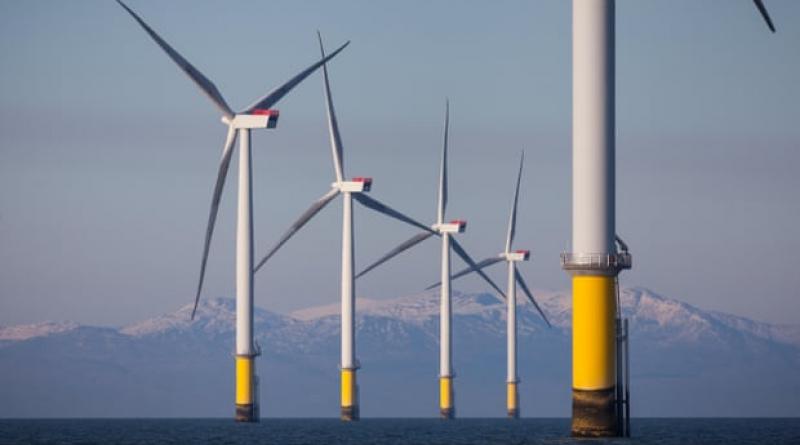Queen's property manager banks huge windfarm bonanza.

Offshore seabed auction lands £4bn over 10 years for Treasury and Crown Estate prompting calls for green sovereign wealth fund.
The Queen and the Treasury are in line for a multibillion-pound bonanza from renewable energy, after a major auction of seabed plots for windfarms off the coasts of England and Wales attracted runaway bids.
The crown estate, which manages the monarch’s property portfolio, holds exclusive rights to lease the seabed around the British Isles. With its first auction of windfarm licences in a decade understood to have reached record highs, the Queen’s income is expected to leap by at least £100m a year, while the takings will generate over £300m a year for the Treasury.
Two windfarm sites within the Irish Sea have reportedly attracted the most frenzied bidding, with energy firms offering to pay as much as £200m for each – a total revenue of £400m a year. Awards for another three areas have yet to be decided. The licences are for 10 years, meaning the auction will raise at least £4bn over a decade.
The vast sums involved have prompted calls for the revenues from Britain’s renewable resources to be kept by the public in a “green sovereign wealth fund” that could be used to invest in tackling the climate crisis.
“Rather than being squirrelled away in Treasury coffers, how much better would it be to use this renewable windfall as initial capital for a sovereign wealth fund that could then be invested for future generations, similar to what we’ve seen the likes of Alaska and Norway do in the past with their oil wealth,” said the Green party co-leader, Jonathan Bartley.
The crown estate declined to comment on the confidential process which requires all participants to sign ironclad non-disclosure contracts to prevent leaking commercially sensitive details about the process before it has concluded.

The identity of the winning bidder is not known, but market sources told the industry journal ReNews that it was likely to be a large oil producer. Companies including BP, Shell and Norwegian oil producer Equinor have all taken an interest in offshore wind as oil revenues decline and pressure rises to pursue green energy portfolios.
The crown estate’s profits from the multibillion-pound windfall would more than double the property manager’s £345m earnings in the last financial year. The money is handed to the Treasury before 25% is returned to the royal household in the form of the sovereign grant.
The sovereign grant was increased in 2017, from its previous level of 15%, to pay for extensive renovations at Buckingham Palace. It will stay at 25% at least until the next five-year review in 2021-2022, meaning the royal household should benefit directly from the money raised from the new windfarm leases.
The crown estate was given the renewable energy exploitation rights to the seabeds around Britain in 2004, under an Energy Act passed while Tony Blair was prime minister. MPs voting through the legislation at the time are unlikely to have predicted the sea change in energy provision now leading forecasters to predict wind will become the dominant energy source in the UK.
The prime minister, Boris Johnson, has set a target for every home in the UK to be powered by offshore wind by 2030.
An industry journal reported this week that windfarm developers were left dismayed at the runaway auction which will lead to “bonkers” revenues for the Queen’s property manager.
The initial auction rounds held earlier this week revealed a winning bid of around £150,000 per megawatt a year for two separate 1.5GW windfarms in the Irish Sea, according to ReNews, or five times higher than the top bids expected in the early rounds.
The winners of the Irish Sea sites will be required to pay the crown estate about £200m a year in “rent” for each licence area, while building the offshore windfarm, or a total of £2bn for each windfarm site over the 10 years it usually takes to develop these projects.
In total, the auction will award leases from 7GW worth of offshore wind power capacity in areas around the English and Welsh coastlines, with the potential to deliver clean electricity for more than 6m homes.
Traditional renewable energy developers are understood to be unhappy about the aggressive auction bids, claiming that the process risks distorting the UK’s green energy market by inflating costs which could ultimately be shouldered by energy billpayers.
The crown estate was forced to overhaul its proposed auction process in 2019 after the industry warned that calling for “closed envelope” bids would lead to excessive prices. Instead, it promised to use daily bidding cycles to make the process more transparent. However, the first round of the auction was still “closed”, leading to an aggressive start.
The auction is ongoing, and the results will be confirmed only once it has closed.
5 February 2021
The Guardian





